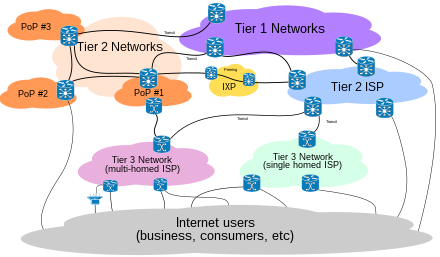| Internet |
|---|
 
A visualization of routing paths through a portion of the Internet.
|
is a business or organization that offers users access to the Internet and related services. Many but not all ISPs are telephone companies or other telecommunication providers. They provide services such as Internet access, Internet transit, domain name registration and hosting, dial-up access, leased line access and colocation. Internet service providers may be organized in various forms, such as commercial, community-owned, non-profit, or otherwise privately owned.
Contents
- 1 History
- 2 Classification
- 2.1 Access providers
- 2.2 Mailbox providers
- 2.3 Hosting ISPs
- 2.4 Transit ISPs
- 2.5 Virtual ISPs
- 2.6 Free ISPs
- 3 Peering
- 4 Law enforcement and intelligence assistance
- 5 See also
- 6 References
- 7 External links
History
The Internet was developed as a closed network between government research laboratories and relevant parts of universities. By the late 1980s, it was slowly moving towards commercial use; these restrictions would be completely removed by 1995, 4 years after the release of the World Wide Web to the general public.In 1989, an ISP had appeared in Australia. In the US the same year, Brookline, Massachusetts-based The World became the first commercial ISP in the US. Its first customer was served in November of 1989.[1]
Classification
Access providers
Main article: Internet access
Access ISPs employ a range of technologies to enable consumers to connect to their network.[2] Over time, available technologies have ranged from acoustic couplers to telephone lines, to cable, wi-fi, and fiber optics.If users and small businesses, traditional options include copper wires to provide dial-up, DSL (typically asymmetric digital subscriber line, ADSL), cable modem or Integrated Services Digital Network (ISDN) (typically basic rate interface). Using fiber-optics to end users is called Fiber To The Home or similar names.[3]
For customers with more demanding requirements, such as medium-to-large businesses, or other ISPs, higher-speed DSL (such as single-pair high-speed digital subscriber line ), Ethernet, metropolitan Ethernet, gigabit Ethernet, Frame Relay, ISDN Primary Rate Interface, ATM (Asynchronous Transfer Mode) and synchronous optical networking (SONET) can be used.[4]
Wireless access is another option, including satellite Internet access.
Many access providers also provide hosting and email services.[5][6][7][8]
Mailbox providers
Main article: Mailbox provider
A mailbox provider is a department or organization that provides email mailbox hosting services. It provides email servers to send, receive, accept, and store email for other organizations and/or end users, on their behalf and upon their explicit mandate.Many mailbox providers are also access providers,[9] while others aren't (e.g., Yahoo! Mail, Hotmail, Gmail, AOL Mail, Pobox). The definition given in RFC 6650 covers email hosting services, as well as the relevant department of companies, universities, organizations, groups, and individuals that manage their mail servers themselves. The task is typically accomplished by implementing Simple Mail Transfer Protocol (SMTP) and possibly providing access to messages through Internet Message Access Protocol (IMAP), the Post Office Protocol, Webmail, or a proprietary protocol.[10]
Hosting ISPs
Hosting ISPs routinely provide email, FTP, and web-hosting services. Other services include virtual machines, clouds, or entire physical servers where customers can run their own custom software.[citation needed]Transit ISPs

In the simplest case, a single connection is established to an upstream ISP and is used to transmit data to or from areas of the Internet beyond the home network; this mode of interconnection is often cascaded multiple times until reaching a Tier 1 carrier. In reality, the situation is often more complex. ISPs with more than one point of presence (PoP) may have separate connections to an upstream ISP at multiple PoPs, or they may be customers of multiple upstream ISPs and may have connections to each one of them at one or more point of presence.[12] Transit ISPs provide large amounts of bandwidth for connecting hosting ISPs and access ISPs.[13]
Virtual ISPs
Main article: Virtual ISP
A virtual ISP (VISP) is an operation which purchases services from another ISP (sometimes called a "wholesale ISP" in this context)[14] which allow the VISP's customers to access the Internet using services and infrastructure owned and operated by the wholesale ISP. It is akin to mobile virtual network operators and competitive local exchange carriers for voice communications.Free ISPs
Free ISPs are Internet service providers which provide service free of charge. Many free ISPs display advertisements while the user is connected; like commercial television, in a sense they are selling the users' attention to the advertiser. Other free ISPs, often called freenets, are run on a nonprofit basis, usually with volunteer staff.[citation needed]Peering
Main article: Peering
ISPs may engage in peering, where multiple ISPs interconnect at peering points or Internet exchange points (IXs), allowing routing of data between each network, without charging one another for the data transmitted—data that would otherwise have passed through a third upstream ISP, incurring charges from the upstream ISP.[11]ISPs requiring no upstream and having only customers (end customers and/or peer ISPs) are called Tier 1 ISPs.[citation needed]
Network hardware, software and specifications, as well as the expertise of network management personnel are important in ensuring that data follows the most efficient route, and upstream connections work reliably. A tradeoff between cost and efficiency is possible.[citation needed]

0 comments:
Post a Comment